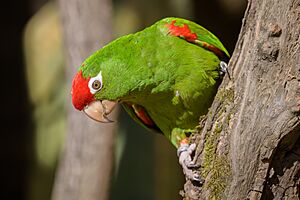Cordilleran parakeet facts for kids
Quick facts for kids Cordilleran parakeet |
|
|---|---|
 |
|
| Conservation status | |
| Scientific classification | |
| Genus: |
Psittacara
|
| Species: |
frontatus
|
| Synonyms | |
|
Psittacara wagleri frontatus |
|
The Cordilleran Parakeet (Psittacara frontatus) is a colorful bird from the parrot family. It lives in the mountains of Ecuador and Peru. Sadly, it is considered a Near Threatened species, meaning its population is decreasing.
Contents
About the Cordilleran Parakeet
What's in a Name?
Scientists often change how they group animals as they learn more. The Cordilleran Parakeet was once in a group called Aratinga. But since about 2013, it has been placed in the Psittacara group.
There are two main types, or subspecies, of the Cordilleran Parakeet. These are P. f. frontatus and P. f. minor. Some scientists even think these might be types of the scarlet-fronted parakeet.
What Does the Cordilleran Parakeet Look Like?
The Cordilleran Parakeet is a medium-sized bird. It is about 34 to 40 centimeters (13 to 16 inches) long. It weighs between 162 and 217 grams (5.7 to 7.7 ounces). Both male and female parakeets look very similar.
Most of their body is green. Their belly is a bit more yellow. Some birds have small red spots on their throat. The front of their head and the top of their wings are bright red. The feathers under their wings and tail are olive-yellow.
Their eyes are pale gray with a white ring of skin around them. Their beak is horn-colored, and their legs and feet are brownish. The P. f. minor subspecies is a bit smaller and greener. It also has lighter red on its head. Young parakeets look like adults but have less red on their heads.
Where Do Cordilleran Parakeets Live?
Their Mountain Home
The Cordilleran Parakeet lives in the Andes mountains. The P. f. frontatus subspecies is found on the western side of the Andes. This includes Loja Province in Ecuador and most of western Peru.
The P. f. minor subspecies lives in valleys between the mountains. You can find it near the Marañón and Pampas rivers in Peru.
What Kind of Places Do They Like?
These parakeets live in many different places. They like the edges of cloudforests and montane forests. They also live in forests along rivers and forests that have grown back.
You might even spot them in farm areas or city parks. In Ecuador, they live at heights from 1,000 to 2,500 meters (3,300 to 8,200 feet). In Peru, they can live as high as 3,000 meters (9,800 feet).
How Do Cordilleran Parakeets Behave?
Moving Around
Scientists don't know much about how far these parakeets travel. They usually fly in small groups.
What Do They Eat?
Cordilleran Parakeets usually look for food high up in the trees. Their diet includes fruits, nuts, and seeds.
Nesting and Babies
We don't know exactly when their nesting season is. They nest in small groups, often in cracks in tall cliffs.
What Sounds Do They Make?
These parakeets are very noisy! Especially when they fly, they make a loud, continuous screeching chatter. They also make squeaky notes and screeches, like "kreee."
Is the Cordilleran Parakeet in Danger?
The IUCN (International Union for Conservation of Nature) says the Cordilleran Parakeet is a Near Threatened species. This means they are not in immediate danger, but their numbers are going down.
We don't know exactly how many of these birds there are. The main reasons their population is shrinking are:
- Being caught by people.
- People harming them.
- Losing their homes (habitat loss).
- Changes in how land is used.
They are rare in Ecuador but can be common in some parts of Peru.


